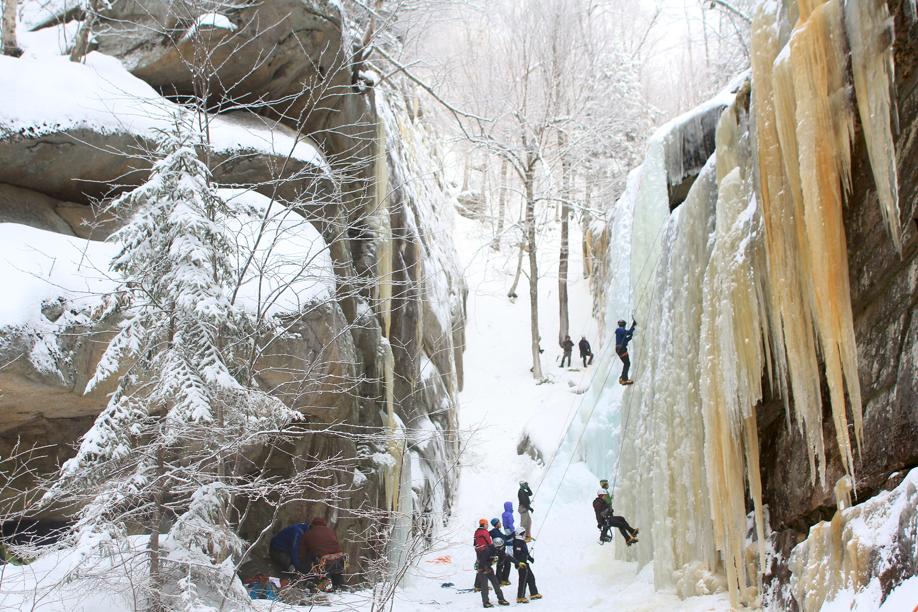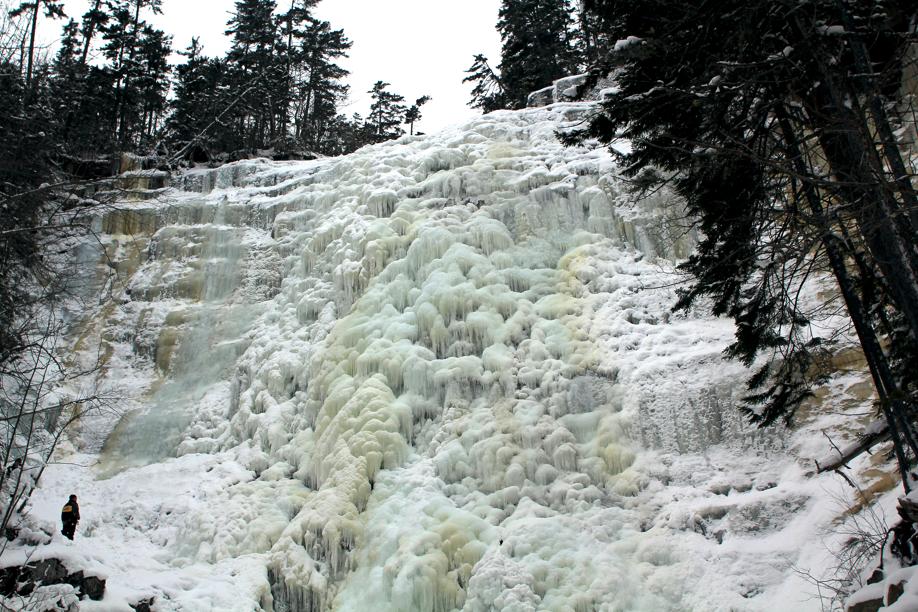

HART’S LOCATION, N.H. — Waterfalls lure both hardy and fresh-off-the couch trekkers to the White Mountains in spring, summer, and fall. Yet this is the season that most spectacularly showcases these sparkling icons.
Winter sculpts an exotic beauty. And with a pair of mountain snowshoes (or microspikes, given the lack of recent snow) and a bit of an adventurous spirit, you will find many waterfalls are remarkably accessible. Here are five treks, of varying lengths and difficulties, to some of the most unusual and stunningly evolved and evolving creations you’ll come across this winter.
Arethusa Falls
At its base, slap on a pair of microspikes or crampons, climb up about a quarter of the falls on the left, and put your ear against the ice. From the unseen recesses come gurgles, punctuated with an echoing plop or two.
These sounds explain what to the eyes seems inexplicable. The waters at Arethusa Falls, among the tallest in New Hampshire, create a massive wall of ice, its width almost matching its 140 feet in height. At the left, the ice is smooth, going from a light blue to white to clear. In the middle, it is a steep series of dimpled Suessian bumps and icicles. At right, serrated sheets and icicles are tawny.
Yet, for all these tons of ice, the only evidence of their source is a small whip of bouncing water that occasionally darts out from the middle of the wall. Most of the creation of this immense slab is done out of sight, a touch of mystery underpinning the magnificence.
To get to the falls, start at the Arethusa Falls parking lot off Route 302. Do a loop trail, starting with the Bemis Brook Trail. It’s mostly flat, offers the brook as your companion, and takes you past Bemis Falls and the picturesque Coliseum Falls, both more like cascades than steep falls. The last couple hundred yards back to the Arethusa Falls Trail are quite steep, safer to ascend than descend. After gaining Arethusa Falls Trail, look for the sign for the spur trail to the falls.
Total distance: 3-plus miles, with a few moderate climbs; elevation gain, about 800 feet.
Bridal Veil Falls
The last 50 steps or so of the approach to these falls can be tricky, for your focus is on the splendid sights above not the sundry hazards underfoot. If ice bridges have not formed, the crossing over Coppermine Brook is a challenge, with success equally determined by strategy, balance, and luck.
You don’t need a closeup view, however, to be enchanted by Bridal Veil. The weeping cliffs create a horseshoe of formations, with icicles hanging from ledges, tree roots, bushes. In the middle of these formations, the waters of the brook tumble to your right before turning toward you and falling another four feet or so before passing atop a broad ledge.
Its trail, Coppermine, starts off Route 116, on the west side of Cannon Mountain. You’ll need to park and walk briefly through a neighborhood to reach the trail. The grade is easy to moderate, with the path paralleling the brook. A cool lean-to shelter provides a staging stop near the falls.
Distance: about 5 miles with 1,100-foot elevation gain.
Franconia Falls
This is a joy-is-in-the-journey hike, with the payoffs along the way equal to those at the destination.
It is also the longest of the five, but in this case, distance is not an accurate gauge of difficulty. The Lincoln Woods Trail, starting at parking lot ($3 usage fee) off Kancamagus Highway is wide and flat. The snowshoeing is a breeze, and with the churning waters of the East Branch of the Pemigewassett River on your right and the trickling of the Osseo Brook on your left, it’s a 360-degree aural tapestry.
The effect is still more dazzling if it’s snowing. The beeches, birches, and ashes form a canopy of white around you. After a tad more than two miles of the trail, where the river briefly turns away, stop and close your eyes for a few moments. The accumulating snow shrouds sounds, save your breathing and heartbeat. Open your eyes and the snow mutes all the colors into veiled grays and soft browns.
Before the trail crosses Franconia Brook, turn left onto Franconia Falls Trail. This narrow, winding trail hugs the banks of the brook. Beware of low snow-laden spruce boughs eager to dump their cold burden down your backs.
The trail frequently opens to views of cascades, pools, ledges, and massive boulders.
Distance: 7 miles with 400-foot elevation gain
Champney and Pitcher falls
If you’re looking for a sense of solitude, stick to the weekdays or early weekend mornings. Otherwise, this site will be crawling with climbers.
The attraction is obvious. A wall of ice, about 50-feet tall, is easily accessible in a tiny gorge. Two falls are prominent. The first is right off the path, the last in a series of drops known as Champney Falls. It is a beautiful 10-foot window of motion bracketed by a column of blue translucent ice on the right and a row of brown opaque icicles on the left. Walk to the far end of the canyon for a thin tumble of water, Pitcher Falls, slicing through the climbers’ play wall.
If you arrive early enough, the falls offer a sacred respite. Because the gorge is so narrow, it has an intimate, near cathedral quality, with the multicolored ice its stained-glass. Yet, if you find yourself surrounded by a dozen or so climbers, that’s cool, too. It’s fascinating to watch how they splice strategy with strength and agility, finding or creating flaws in the ice to climb to the top.
The Champney Falls Trail starts off the Kancamagus Highway ($3 fee). Champney Brook is often a companion on the trail, sometimes at the same level of your steps, other times 30 feet below.
Distance: 3.5 miles with 500-foot elevation gain.
Flume Gorge
This is the trek for those short on time or energy. In 15 minutes, you can be standing at the edge of a chasm encased in colorful striated ice.
Start at the Flume Visitors’ Center, off the Franconia Notch Parkway. One of the busiest tourist places in the Whites in the summer, the center is closed in the winter and barren of information, except for a placard declaring the inner gorge closed to hikers, its boardwalk removed. Don’t be deterred.
Cross an iconic red and white covered bridge over the Pemigewassett River (means swift current, in Abenaki language) and follow the path as it hugs the racing Flume Brook. This walk ends as the gorge begins. Soak in the ice-encrusted cliffs, then veer left and climb a heart-thumping path to the top of the gorge. Here you’ll find respite in both the man-made — a lean-to — and the natural, an open, shallow cave. Clamber down the path to the Avalanche Falls. Waters spraying and tumbling 45 feet over the rocks, framed in blue and white and clear ice, are stunning.
On weekends, you’ll be sharing the sights and sounds with ice climbers, their colorful parkas specks against the cliffs. It’s excellent theater, the age-old woman/man against the elements, stripped to a simple frame. With considerable strength, stamina, and strategy, they ascend what temperature, water, and gravity so effortlessly render.
Distance: about a mile, with minimal elevation gain.
Michael J. Bailey can be reached at michael.bailey@globe.com



